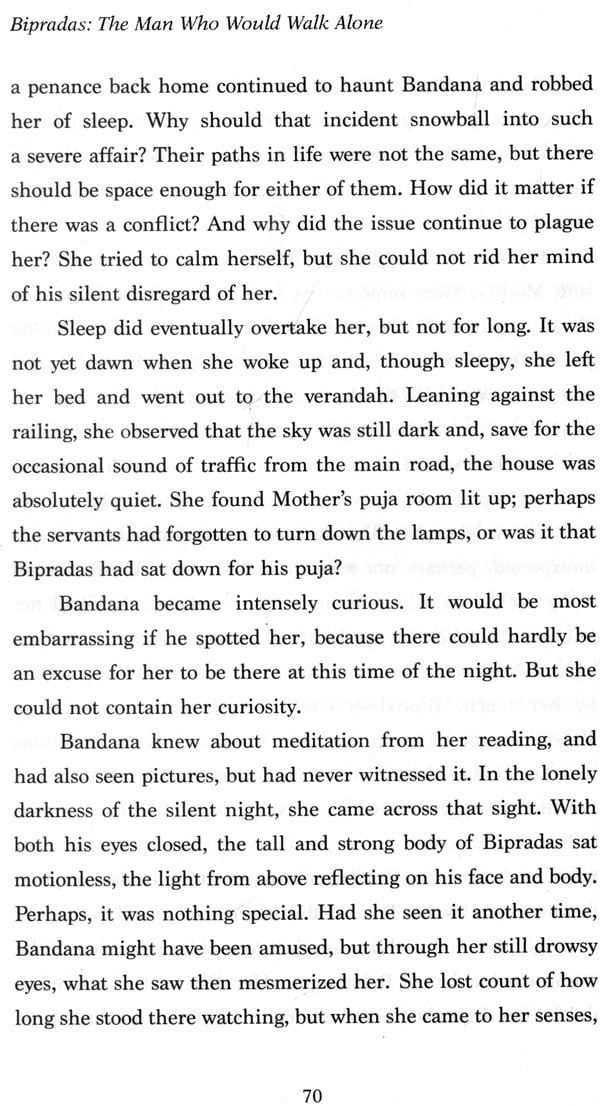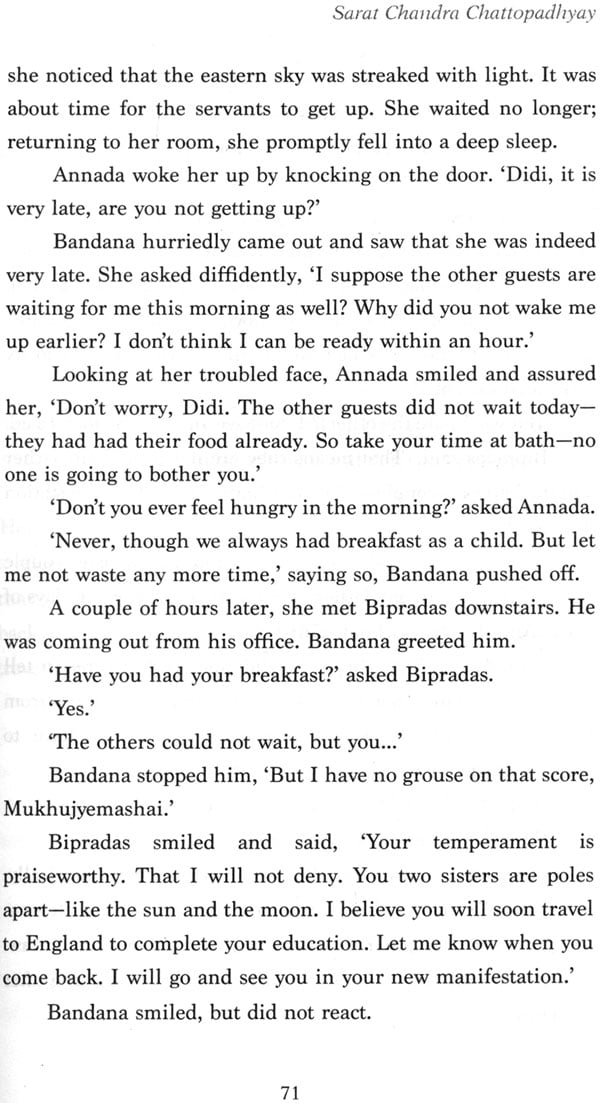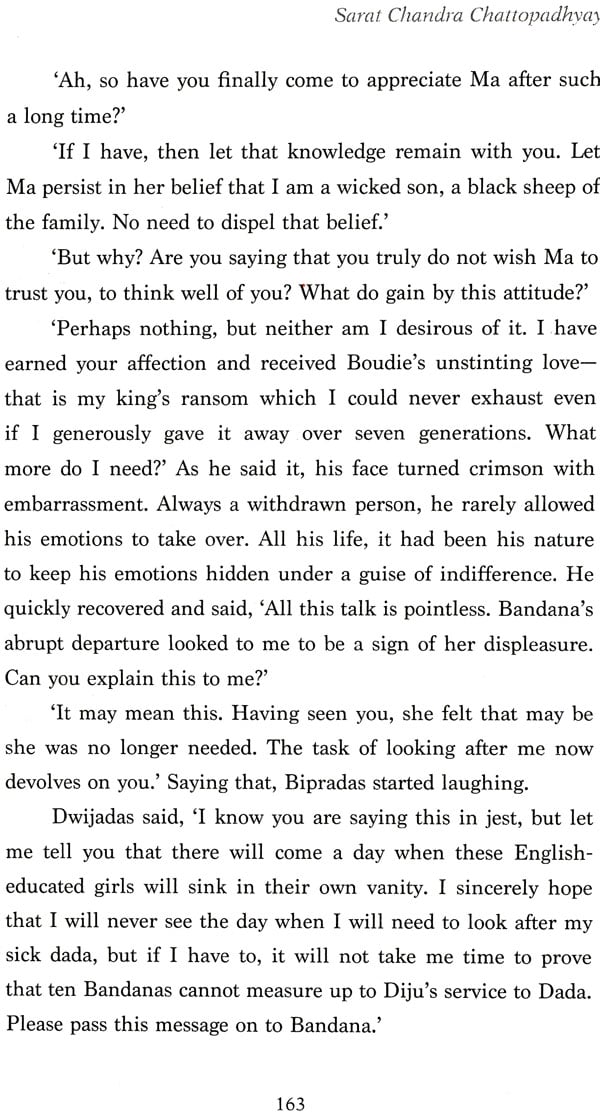
Bipradas - The Man Who Would Walk Alone
Book Specification
| Item Code: | NAO706 |
| Author: | Sarat Chandra Chattopadhyay |
| Publisher: | Niyogi Books |
| Language: | English |
| Edition: | 2018 |
| ISBN: | 9789386906403 |
| Pages: | 264 |
| Cover: | Paperback |
| Other Details | 8.5 inch X 5.5 inch |
| Weight | 320 gm |
Book Description
About the Book
Set against a rural backdrop of 20th century Bengal, the story Bipradas (1935) revolves around the life and family of the central protagonist Bipradas, who is also the charismatic hero of the novel. A conflict of cultures is at play here—ancient Indian Hindu versus the modern culture, influenced mainly by western education and reformatory ideas.
While Biprads comes forth as a man of firm determination and high principles, Dwijadas, Bipradas’s younger brother, is portrayed as a freedom-loving person with his own set of thoughts. Then enters Bandana—Bipradas’s wife Sati’s cousin—a young, beautiful, modern-day girl, who immediately gets attracted by Biprads’s personality and courage of conviction.
A series of tragic events follow. Bipradas has to leave home with his wife and son, practically penniless. Bandana gets married to Dwijadas to hold the Mukhujye family together. And a shattering news rocks the family.
Will Bandana be able to hold the reins the disarrayed family at the end of it all ?
Sarat Chandra Chattopadhyay (1876-1938) was an illustrious Bengali novelist and short writer of the early 20th century. Many of his stories narrate the lives, tragedies, and struggles of the village people and the contemporary social practices that prevailed in Bengal. His writing matured at a time when the national movement was gaining momentum together with an awakening of social consciousness.
Sensitive and daring, his novels captivated the hearts and mind of innumerable readers both in Bengal and the rest of India. His best known novels include Palli Samaj (1916), Choritrohin (1917), Devdas (1917), Nishkriti (1917) Datta (1918) Griha Daha (1920), and Sesh Prashna (1929). Many of his stories were adopted for well-crafted and popular flims in Bengali and Hindi languages for many years, extending even to the 21st century.
He remains the most popular, most translated, most adapted, and the most plagiarized Indian author of all time.
Translator’s Note
Translations are major conduits to spread knowledge and information or various subjects throughout the world. The world has made considerable progress due to the availability of ideas and discoveries by great men and women in translation throughout the past many centuries and in present times.
In our country, from times immermorial, the epics Ramayana and Mahabharata have been considered as important treatises handed down through generations, initially by oral narrations and subsequently in translations in diverse India languages. The original language of both these epics was Sanskrit, which was accessible to only a few scholarly persons, and hence the many translations in various Indian languages.
Bipradas is regarded as one of the best works of Sarat Chandra Chattopadhyay. This book is perhaps somewhat offbeat in terms of Sarat Chandra’s usual metier. The theme of Bipradas is a conflict of cultures—ancient Indian Hindu culture versus the modern culture, influenced mainly by western culture, western education, and reformatory ideas.
Bipradas, the protagonist of this novel, is unique. He is young and handsome, physically strong, of power moral fiber, and a most determined character not amenable to unprincipled compromises. Although held by all in great respect and awe, he is compassionate by nature.
By all accounts, he is a supremely rational man; yet he believes in orthodox Hindu culture and its rituals, including caste system and contamination by touch. Though he did not have much formal education, he happens to be extremely well educated with wide reading. He efficiently manages the affairs of his vast estate as well as the family, and his style of management is often regarded as autocratic.
Then arrives Bandana, the cousin of Bipradas’s wife Sati, and conflict follows. Bandana is a young girl of the new age and well-cultivated. She lives in Bombay with her father and leads a Western lifestyle. They consider conservative Hindu rituals abhorrent and unacceptable. She is revolted when she discovers that no one in Bipradas’s family would drink water or eat food offered by her father or herself. Apparently, they are considered untouchables!
Surprisingly, or perhaps not so surprisingly, living for a time with this archly orthodox family makes Bandana curious about how such ancient rites and rituals keep the family together. Progressively, Bandana comes to appreciate these rituals, almost to the point of becoming a convert. She is vastly attracted by Bipradas—his personality, his intellect, and the courage of his conviction.
A tragedy then strikes the family. Bipradas falls out with his sister’s husband Sasadhar, whom he accuses of cheating him, and asks Sasadhar to leave his home. Dayamoyee intervenes and disagrees to abandon her son-in-law. As a result, it is Bipradas who leaves home with his wife and child, practically penniless.
Shortly thereafter, Sati dies while in exil, and Biprads returns home for his son to perform his mother’s funeral rites. Ona piteous appeal from Dwijadas, Bandanas, promptly arrives to hold the reins of a disarrayed home. She agrees to marry Dwijadas with Bipradas’s consent, and begs Bipradas to let her keep his son with her. Having renounced the worldly life, Bipradas soon leaves home, and with him goes his mother Dayamoyee on a pilgrimage. Dayamoyee would return home sooner or later, but never would Bipradas.
Translation from one language to another is always arduous, since no two language are truly equivalent in anything except the simplest terms. There was no way in spite of my best efforts to match my translation with the elegant Bengali of Sarat Chandra. I had thought it right to be as faithful to the original text as was possible. Some liberties had to be taken where translations did not convey with any degree of fidelity the nuances of the original language. Such liberties have been minimal.
The text adopted in this translation is taken from Sarat Chandra’s collected works published by Sarat Samity.
I am, as usual, deeply grateful to my wife Bharati for all her help and encouragement. I am also indebted to Mr Nirmal Kanti Bhattacharjee for his help.













